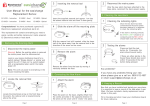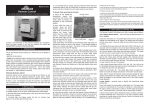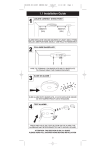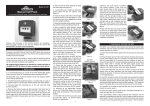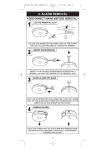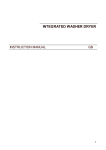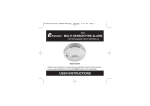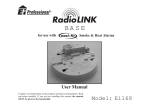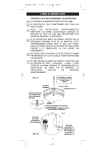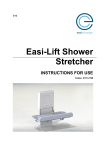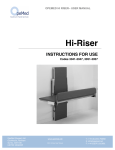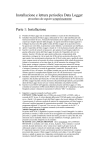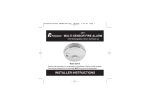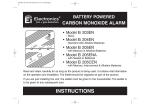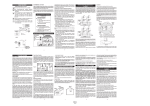Download 2 User Manual for the easichange Replacement Series: 1 3 4 5 6 1 2
Transcript
3 Insert the removal tool 1 User M a n u a l f o r t h e e a s i c h a n g e Replacement Series: E i151EK - Ion i s a t i o n Ei154EK - Heat E i 1 5 6 E K - O p t i c al Congratulations! You have purchased a genuine Ei Electronics replacement smoke/heat alarm kit. 1 D i s c o n n e c t t h e mains power Warning! Before the existing alarm is removed the mains power must be disconnected. Look on your mains distribution board for a switch marked “Smoke Alarms” or similar and switch this off. If there isn’t a switch marked with a recognisable label, switch the mains power off. Note: This will cut power to everything in the house including the lights. 2 L o c a t e t h e t a m per catch Connect the terminal block Insert the supplied removal tool into the left hand side of the tamper catch and lever it down gently. 4 Slide the alarm off the mounting pl a t e This replacement kit contains everything you need to easily, quickly and safely replace your mains powered, Ei Electronics smoke or heat alarm. 1. R e m o v i n g t h e E x i sting Alarm 2. Connecting the New Alarm Plug the power and interconnection terminal block into the back of the new alarm. Note: The block will only connect one way. 2 Attach the alarm With the removal tool still inserted, slide the lower half of the alarm away from the removal tool, the alarm will detach from the base. 5 Remove the alarm Place the alarm on the base plate and slide it towards the tamper catch until it “clicks” into place. 3 After the new alarm has been attached to the base plate, reconnect the mains power supply. Gently move the alarm vertically towards the floor. It is important to do this slowly as the alarm is still attached with its power and interconnection cable. 6 Unplug the terminal block Reconnect the mains power 3. Checking the new Alarm 1 Checking the indicating lights Once the new alarm has been connected and the mains power has been restored it is important to check the indicating lights. The tamper catch is located on the opposite side to the alarm hinges (as shown in the above image). Page 1 Unplug the power and interconnection terminal block from the back of the alarm. Care should be taken to pull the terminal block and not the cables. Page 2 If the alarm is working correctly the GREEN LIGHT (mains indicating light) should be on constantly and the RED LIGHT should flash once every 40 sec. Page 3 2 Te s t i n g t h e A l a rms Press and hold the test button for 10 seconds, the alarm should sound loudly and the R E D L I G H T should flash while the alarm is sounding. If there are other alarms in the house these should also sound within 5 seconds of the test button being pressed. Any P r o b l e m s ? If yo u h a v e a n y p r o b l ems fitting your new alarm p l e a s e g i v e u s a call on: 0800 612 483 7 or em a i l s u p p o r t @ e a sichange.co.uk Test weekly - press and hold the test button on the alarm for 10 seconds. The alarm will sound loudly and the red light should flash rapidly. All other interconnected alarms should also sound. Remove or completely cover your alarm when decorating to prevent dust and contamination damaging the unit. Do not allow paint, water or dust to contaminate your alarm. Your alarm is a mains 230V AC electrical appliance. Do not open or insert anything into the alarm. Do not paint your alarm - It may alarm or cease to operate. 4. K e e p i n g a R e c o r d Now that you have installed and tested your new alarm, it is essential to keep a record of the date when it was fitted. We have included a handy replacement record sticker in this pack. Fill in the date and stick it near your distribution board for future reference. If your alarm sounds for no reason and will not reset, it can be removed by releasing the clip on the base. (See “Removing the Existing Alarm” section on page 1) Page 4 Check all your alarms at least weekly, and also after re-occupation following a holiday etc. 1. Check that the green mains indicator light is on, If it is off check circuit breakers, fuses and wiring etc. Check that the red light behind the button or on the cover flashes every 40 seconds. 2. Press the test button for up to 10 seconds to ensure the sensor chamber, electronics and sounder are working. A red light behind the test button or on the cover, will flash while horn is sounding. The alarm will stop when the button is released. Pressing the test button simulates the effect of smoke or heat during a real fire and is the best way to ensure the alarm is operating correctly. WARNING: DO NOT TEST WITH FLAME The can damage the alarm and can be a fire risk We do not recommend testing the alarms with smoke or heat as the results can be misleading unless special apparatus is used. 3. Check for any sign of contamination such as cobwebs or dust and clean the alarm as described below if necessary. Test the first unit by pressing the test button for 10 seconds. All the detectors should alarm within about 5 seconds of the first horn sounding and the red light on the first unit only will flash about once a second. Check all the other units similarly. Regularly check that the green mains Indicator light on the cover is lit. Clean your alarm regularly. This will reduce the risk of false alarms. Checking your Alarms Interconnected Alarms 5. I m p o r t a n t I n f o r m a tion If a nuisance alarm occurs, fan the alarm v igorously with a newspaper to help clear the sensor (on the Ei151EH press the hush button in the corner of the cover). 7 . Te s t i n g & M a i n t a i n i n g Yo u r A l a r m Note: Ionisation and heat alarms signal to other interconnected alarms within about 4 seconds of their own sounder being activated, optical alarms signal within approximately 1 second. The rechargeable cells may require a few days to charge after first being connected to the mains. It may give a short beep every 40 seconds for up to 2 hours while it is charging. Page 5 Checking the Rechargeable Cells When the Alarm is Beeping The Alarm automatically monitors the cells every 40 seconds to ensure they are satisfactory. If a problem is identified it will give a short beep every 40 seconds. If the unit is giving beeps then check the following: Page 6 1. Check that the green mains power light is on. If it is off the alarm has been powered from the cells and the beeps indicate they are depleted. Reconnect the mains, check fuse, circuit breakers and wiring. If in doubt contact a qualified electrician. The beep s should cease within 2 hours as the cells charge up. 2. Check that the hush button has not been pressed inadvertently (Ei151EH only). This also causes beeps every 40 seconds for up to 15 minutes. Press the test button to cancel hush mode beeps. 3. The cells may be depleted. The beeps should cease within 2 hours as they charge up. Fully charged, the cells will provide up to 6 months back-up without mains power. 4. On the Optical Smoke Alarms only (Ei156EH) if the unit beeps and the red light does not flash at the same time it indicates a problem with the smoke chamber - see Cleaning the Smoke Alarm. If all of the above possible causes of beeps have been ruled out but the beeping has still persisted for over 2 hours with the green light on - the rechargeable cells are probably defective. The smoke alarm must be returned to us at one of the addresses on the back page for examination and analysis. Manual Testing We recommend that the functioning of the rechargeable cells is checked periodically (at least yearly) as follows: 1. Ensure that the alarm has been connected to the mains, with green light on, for a least 2 days for the cells to charge. 2. Turn off the mains power at the distribution board and check that the green indicator light is extin guished. Do not remove the plug from the rear as this will disconnect the cells. 3. Press the test button and ensure the horn sounds loudly for 10 seconds. 4. Release the test button and watch it carefully for one minute: - The red light behind the test button or on the cov er will flash at least once. - The unit must not give a beep which indicates the battery is low. 5. Turn on the mains supply at the distribution board only if the unit passes all the above tests. Page 7 Note: If the mains is disconnected and the battery is almost depleted the unit will beep every 40 seconds for at least 72 hours. This is to remind you to re-connect the mains supply. The unit will operate from the mains alone, even with a fully depleted or a defective battery, though it may not give sufficient warning of fire if the mains supply is disconnected for any reason. If there are any problems get a qualified electrician to inspect the house wiring and connections to the alarms. If there are still problems the smoke alarm must be returned to us at one of the addresses on the back page for examination and analysis. 9. Cleaning Your Alarm WARNING: Electrical shock hazard. Disconnect the AC mains at the fuse box or circuit breaker powering the alarm before following the cleaning instructions. Clean your Alarm regularly, particularly in dusty ar eas. Use the narrow nozzle attachment of your vacuum cleaner to remove dust, insects and cobwebs from the sides and cover slots where the smoke or heat enters. To clean the cover, wipe with a damp cloth. Dry cover thoroughly with a lint free cloth. If the contamination around the outer case indicates that the area is particularly dirty, remove the alarm from the ceiling (See “Removing the Existing Alarm” section on page 1). 1. Check that the openings in the black smoke sensing chamber are not clogged by visually inspecting them through the large openings around the edges of the smoke alarms. If they are clogged (an extremely rare occurance) the Smoke alarm must be replaced. WARNING: Do not paint your Alarm. Other than the cleaning described above, no other customer servicing of this product is required. Repairs, when needed, must be performed by the manufacturer. All alarms are prone to dust and insect ingress which can cause false alarms or failure to alarm. T h e l a t e s t d e s i g n , m a t e r i a l s a n d m a n u f a c t u r i n g t e c h n i q u e s have been u s e d i n t h e c o n s t r u c t i o n o f t h e a l a r m t o m i n i m i s e t h e e ff e c t s of c o n t a m i n a t i o n . H o w e v e r i t i s i m p o s s i b l e t o c o m p l e t e l y e l i m i nate the e ff e c t o f d u s t a n d i n s e c t c o n t a m i n a t i o n , a n d t h e r e f o r e , t o p rolong the l i f e o f t h e a l a r m y o u m u s t e n s u r e t h a t i t i s k e p t c l e a n s o t h at excess d u s t d o e s n o t b u i l d u p . A n y i n s e c t s o r c o b w e b s i n t h e v i c i n i ty of the alarm should be promptly removed. Page 8 In certain circumstances even with regular cleaning, contamination can build up in the smoke sensing chamber causing the alarm to sound or fail. If this happens the alarm must be returned to us for servicing or replacement. Contamination is beyond our control, it is totally unpredictable and is considered normal wear and tear. For this reason, contamination is not covered by the guarantee and a charge is made for servicing such alarms. If you experience persistent false alarms, in particular locations, due to contamination of the smoke chamber you could consider replacing optical smoke alarms with ionisation smoke alarms. Ionisation type alarms are less susceptible to dust than optical type alarms. 10. Nuisance Alarms Alarms caused by cooking fumes etc. can be readily silenced by fanning the unit with a newspaper or similar. On the Ei151EH units, simply press the hush button. If, when the alarm goes off, there is no sign of smoke, heat or noise to indicate that there is a fire, you should get your family into a safe place before you start investigating. Check the house carefully in case there is a small fire smouldering somewhere. Check whether there is some source of smoke or fumes, for example cooking fumes being drawn past the smoke alarm by an extractor. If there are frequent nuisance/false alarms it may be necessary to re-locate the device away from the source of the fumes. If for some reason the alarm continues to sound without smoke or heat being present (due to insect infestation or contamination build-up for example) switching off the mains power alone will not silence the alarm as it will still be powered by the cells. Switch off the mains and remove the plug from the rear of the alarm to disconnect the cells. If cleaning the smoke alarm does not correct the problem it can be returned to one of the addresses on the back page for examination and analysis. Hush Feature The smoke alarms (Ei151EH only) have a hush button to help you control nuisance false alarms. Page 9 1. To cancel a false alarm, press the Hush Button lo cated on the lower right-hand corner. The Alarm will automatically switch to a reduced sensitivity condi tion (very large levels of smoke from a nearby fire will override the Hush). This condition allows unwanted alarms to be silenced for a period of approximately 10 minutes. The unit will give a short beep every 40 seconds during this time to let you know the unit has been silenced. On interconnected Smoke Alarms, pressing the Hush Button on the one sensing smoke (i.e. the one with the red light flashing every se cond) will silence all alarms. Pressing the Hush Button on any other smoke alarm will not cancel the alarm. 2. The unit will reset to normal sensitivity at the end of the silenced period. If additional silenced time is required, simply push the Hush Button again. 3. To quickly return to normal non-silenced operation, simply push the Test Button; the alarm will sound briefly and return to its normal sensitivity and operatio n. 3. After installation, your Smoke Alarm may beep ap proximately every 40 seconds for 15 minutes. This indicates it is in the H ush mode. To put it into nor mal operating mode, push and hold the Test Button until the alarm sounds. 11. Tr o u b l e s h o o t i n g Alarm Sounds for no Apparent Reason: 1. Identify the alarm source. On interconnected units the red light under the test button or on the cover will flash rapidly only on the unit which is the source of the alarm. 2. Check for fumes, steam etc. from the kitchen or bathroom. Paint and other fumes can cause nuisance alarms. 3. Fan the unit vigourously with a newspaper to disperse fumes. 4. If alarm does not stop, switch off the mains power and remove unit (See “Removing the Existing Alarm” section on page 1). 1. If the above fails to turn on the green light, a fault may exist. Switch off the mains power and remove the unit (See “Removing the Existing Alarm” section on page 1). 2. If the green mains light is on and the action in (1) above has not silenced the beeping, a fault may exist. Switch off the mains power and remove the unit (See “Removing the Existing Alarm” sect ion on page 1). Interconnected Alarms do not all Sound: 1. Hold test button for 10 seconds after first alarm has sounded to ensure signal is transmitted to all units. 2. Switch off mains and check that live, neutral and interconnect cables have been correctly connected and that the connections are tight. If Frequent Nuisance Alarms Occur: 1. Close kitchen/bathroom door when in use. 2. Ensure that the alarm is sited at least 6m away from sources of fumes. 3. Contamination from insects, paint or paint fumes may have occured. Clean the alarm. 4. If the problem persists, resiting of the unit should be considered. Alternatively, replace the unit with an optical unit, assuming that the problem is with an Ionisation type alarm. C o n s t r u c t i o n P r o d u c t Ty p e : S m o k e A l a r m D e v i c e s European Standard: EN14604:2005 Certificate of Conformity: 0086-CPD-537430 Model Type Ei141 Ionisation 230V Smoke Alarm Ei146 Optical 230V Smoke Alarm Ei161 Ionisation 230V Smoke Alarm Ei166 Optical 230V Smoke Alarm 0086 08 Alarms Beep Continuously: 1. Alarms may be in ‘hush mode’. Press the test button for 10 seconds to reset the unit (Ei 151EH only). 2. Cells may be flat due to mains failure. Check the green mains indicator light is on. Page 10 P a g e 11 1 2 . F i v e Ye a r G u a r a n t e e Ei Electronics guarantees this alarm for five years from date of purchase against any defects that are due to faulty materials or workmanship. This guarantee only applies to normal conditions of use and service, and does not include damage resulting from accident, neglect, misuse, unauthorised dismantling, or contamination howsoever caused. This guarantee excludes incidental and consequential damage. If this alarm should become defective within the guarantee period, it must be returned, with proof of purchase, carefully packaged, with the problem clearly stated. We shall at our discretion repair or replace the faulty unit. Do not interfere with the alarm or tamper with it. This will invalidate the guarantee, but more importantly may expose the user to shock or fire hazards. This guarantee is in addition to your statutory rights as a consumer. Distributed By: easichange . c/o Safelincs Ltd, Unit 1 Farlesthorpe Road, Lincolnshire, LN13 9PS U.K. Tel: 0800 612 4837 www.easichange.co.uk Manufactured By: Ei Electronics. Shannon, Co Clare, Ireland Tel: +353 (0)61 471377 www.eielectronics.co.uk Aico Ltd. Mile End Business Park, Maesbury Rd, Oswestry, Shropshire, SY10 8NN, U.K. Tel: 0870 758 4000 www.aico.co.uk The crossed out wheelie bin symbol that is on your product indicates that this product should not be disposed of via the normal household waste stream. Proper disposal will prevent possible harm to the environment or to human health. When disposing of this product please separate it from other waste streams to ensure that it can be recycled in an environmentally sound manner. For more details on collection and proper disposal, please contact your local government office or the retailer where you purchased this product. Page 12




